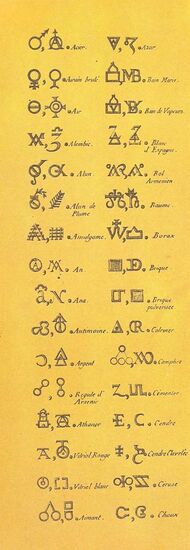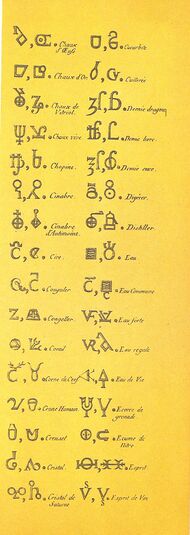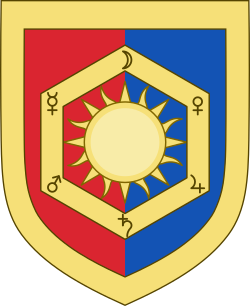Unsolved:Alchemical symbol

|

|
| Alchemical symbols before Lavoisier | |
Alchemical symbols, originally devised as part of alchemy, were used to denote some elements and some compounds until the 18th century. Although notation was partly standardized, style and symbol varied between alchemists. Lüdy-Tenger[1] published an inventory of 3,695 symbols and variants, and that was not exhaustive, omitting for example many of the symbols used by Isaac Newton. This page therefore lists only the most common symbols.
Three primes
According to Paracelsus (1493–1541), the three primes or tria prima – of which material substances are immediately composed – are:[2]
- Sulfur or soul, the principle of combustibility: 🜍 (
 )
) - Mercury or spirit, the principle of fusibility and volatility: ☿ (
 )
) - Salt or body, the principle of non-combustibility and non-volatility: 🜔 (
 )
)
Four basic elements
Western alchemy makes use of the four classical elements. The symbols used for these are:[3]
Seven planetary metals

The seven metals known since Classical times in Europe were associated with the seven classical planets; this figured heavily in alchemical symbolism. The exact correlation varied over time, and in early centuries bronze or electrum were sometimes found instead of mercury, or copper for Mars instead of iron; however, gold, silver, and lead had always been associated with the Sun, Moon, and Saturn.[note 1] The associations below are attested from the 7th century and had stabilized by the 15th. They started breaking down with the discovery of antimony, bismuth, and zinc in the 16th century. Alchemists would typically call the metals by their planetary names, e.g. "Saturn" for lead, "Mars" for iron; compounds of tin, iron, and silver continued to be called "jovial", "martial", and "lunar"; or "of Jupiter", "of Mars", and "of the moon", through the 17th century. The tradition remains today with the name of the element mercury, where chemists decided the planetary name was preferable to common names like "quicksilver", and in a few archaic terms such as lunar caustic (silver nitrate) and saturnism (lead poisoning).[4][5]
- Lead, corresponding with Saturn ♄ (
 )
) - Tin, corresponding with Jupiter ♃ (
 )
) - Iron, corresponding with Mars ♂ (
 )
) - Gold, corresponding with the Sun ☉ 🜚 ☼ (
 24px
24px  )
) - Copper, corresponding with Venus ♀ (
 )
) - Quicksilver, corresponding with Mercury ☿ (
 )
) - Silver, corresponding with the Moon ☽ or ☾ (
 or
or  ) [also 🜛 in Newton][6]
) [also 🜛 in Newton][6]
Mundane elements and later metals

- Antimony ♁ (
 ) (in Newton), also 24px
) (in Newton), also 24px - Arsenic 🜺 (
 )
) - Bismuth ♆ (
 ) (in Newton), 🜘 (
) (in Newton), 🜘 ( ) (in Bergman)
) (in Bergman) - Cobalt
 (approximately 🜶) (in Bergman)
(approximately 🜶) (in Bergman) - Manganese
 (in Bergman)
(in Bergman) - Nickel
 (in Bergman; previously used for regulus of sulfur)
(in Bergman; previously used for regulus of sulfur) - Oxygen
 (in Lavoisier)
(in Lavoisier) - Phlogiston
 (in Bergman)
(in Bergman) - Phosphorus
 or
or 
- Platinum
 or
or  (in Bergman et al.)
(in Bergman et al.) - Sulfur 🜍 (
 ) (in Newton)
) (in Newton) - Zinc
 (in Bergman)
(in Bergman)
Alchemical compounds
The following symbols, among others, have been adopted into Unicode.
- Acid (incl. vinegar) 🜊 (
 )
) - Sal ammoniac (ammonium chloride) 🜹 (24px)[5]
- Aqua fortis (nitric acid) 🜅 (24px), A.F.[5]
- Aqua regia (nitro-hydrochloric acid) 🜆 (
 ), 🜇 (24px), A.R.[5]
), 🜇 (24px), A.R.[5] - Spirit of wine (concentrated ethanol; called aqua vitae or spiritus vini) 🜈 (24px), S.V. or 🜉 (24px)
- Amalgam (alloys of a metal and mercury) 🝛 (24px) = a͞a͞a, ȧȧȧ (among other abbreviations).
- Cinnabar (mercury sulfide) 🜓 (
 )
) - Vinegar (distilled) 🜋 (
 ) (in Newton)
) (in Newton) - Vitriol (sulfates) 🜖 (24px)[5]
- Black sulphur (residue from sublimation of sulfur) 🜏 (
 )[7]
)[7]
Alchemical processes

The alchemical magnum opus was sometimes expressed as a series of chemical operations. In cases where these numbered twelve, each could be assigned one of the Zodiac signs as a form of cryptography. The following example can be found in Pernety's Dictionnaire mytho-hermétique (1758):[8]
- Calcination (Aries
 ) ♈︎
) ♈︎ - Congelation (Taurus
 ) ♉︎
) ♉︎ - Fixation (Gemini
 ) ♊︎
) ♊︎ - Solution (Cancer
 ) ♋︎
) ♋︎ - Digestion (Leo
 ) ♌︎
) ♌︎ - Distillation (Virgo
 ) ♍︎
) ♍︎ - Sublimation (Libra
 ) ♎︎
) ♎︎ - Separation (Scorpio
 ) ♏︎
) ♏︎ - Ceration (Sagittarius
 ) ♐︎
) ♐︎ - Fermentation (Capricorn
 ) ♑︎ (Putrefaction)
) ♑︎ (Putrefaction) - Multiplication (Aquarius
 ) ♒︎
) ♒︎ - Projection (Pisces
 ) ♓︎
) ♓︎
Units
Several symbols indicate units of time.
Gallery
A list of symbols published in 1931:
Unicode
The Alchemical Symbols block was added to Unicode in 2010 as part of Unicode 6.0.[9]
See also
Other symbols commonly used in alchemy and related esoteric traditions:
- Astronomical symbols
- Astrological symbols – Symbols denoting astrological concepts
- Planet symbols
- Suns in alchemy
- Circled dot (disambiguation)
- Monas Hieroglyphica
- Rub el Hizb
- Seal of Solomon
- Rosy Cross
- Eye of Providence – Symbol of the Seal of the United States of America and symbol of Freemasonry (Organization)
- Sigil, as used by Hermetic theurgists
Footnotes
References
- ↑ Fritz Lüdy-Tenger (1928) Alchemistische und chemische Zeichen. Wolfgang Schneider (1962) Lexicon alchemistisch-pharmazeutischer Symbole covers many of the same symbols with a cross-index and indicates synonyms.
- ↑ Holmyard 1957, p. 170; cf. Friedlander 1992, pp. 75–76. For the symbols, see Holmyard 1957, p. 149 and Bergman's table as shown above.
- ↑ Holmyard 1957, p. 149.
- ↑ 4.0 4.1 Crosland, Maurice (2004). Historical Studies in the Language of Chemistry.
- ↑ 5.0 5.1 5.2 5.3 5.4 Holmyard 1957, p. 149
- ↑ Newman, William R.; Walsh, John A.; Kowalczyk, Stacy; Hooper, Wallace E.; Lopez, Tamara (March 6, 2009). "Proposal for Alchemical Symbols in Unicode". p. 13, 2nd from bottom. https://webapp1.dlib.indiana.edu/newton/fonts/Alchemy%20Unicode%20Proposal---March%2031%202009.pdf.
- ↑ Explanation of the Chimical Characters from Nicaise Le Febvre, A compleat body of chymistry, London, 1670.
- ↑ See Holmyard 1957, p. 150.
- ↑ "Unicode 6.0.0". Unicode Consortium. 11 October 2010. https://www.unicode.org/versions/Unicode6.0.0/.
Works cited
- Friedlander, Walter J. (1992). The Golden Wand of Medicine: A History of the Caduceus Symbol in Medicine. Contributions in Medical Studies, 35. New York: Greenwood Press. ISBN 0-313-28023-1.
- Holmyard, Eric J. (1957). Alchemy. Harmondsworth: Penguin Books. OCLC 2080637.
- Reutter de Rosemont, Louis (1931). Histoire de la pharmacie a travers les ages. II. Paris: J. Peyronnet. 4 plates after p. 260 and 2 plates after p. 268. https://archive.org/details/BIUSante_141959x02.
External links
- wikt:Appendix:Unicode/Alchemical Symbols
- Alchemical symbols in Unicode 14.0
 |










